The PLDD Method
Percutaneous Laser Disc Decompression
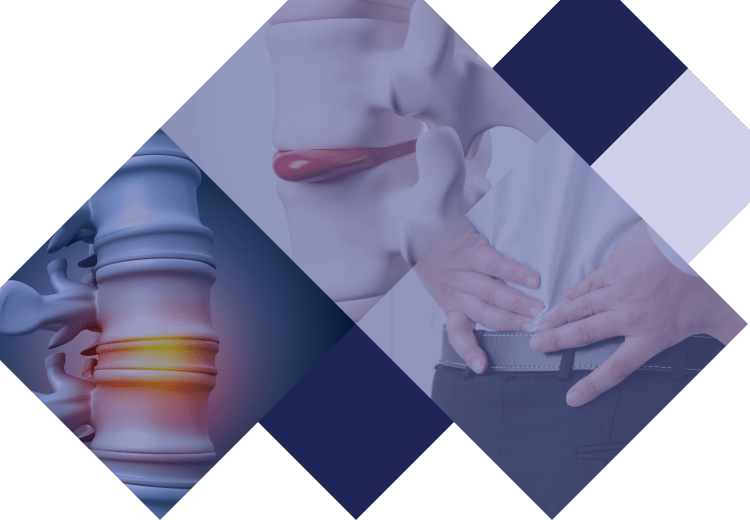
What is the PLDD method?
Percutaneous Laser Disc Decompression
PLDD is a laser treatment to reduce the pressure inside the disc, which is the cause of disc herniation. PLDD has a long history in Japan and has been used since the 1980s. Many patients in Japan have received this treatment. However, PLDD only treats herniated discs, and may not be suitable for patients with collapsed and worn discs.
In our clinic, the Cellgel method or PODD (ozone therapy) method may be recommended depending on the extent of damage on the disc.
Treatment with PLDD (Percutaneous Laser Disc Decompression)
Under local anesthesia, a 1.0 mm puncture needle is inserted in the disc while using X-ray fluoroscopy equipment. A laser is then used to irradiate the lesion according to its condition.
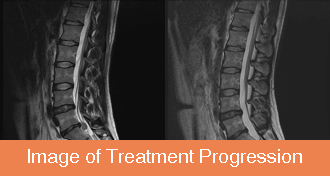
Conditions and Symptoms Treated
-
Conditions / Spinal Diseases
- Lumbar Disc Herniation
For those with these concerns...
-
1
I've been diagnosed with lumbar disc herniation
-
2
I suffer from chronic pain due to disc herniation
-
3
I'm considering surgery for my disc hernia, but I'd like to avoid it if I can
-
4
Past surgery for my disc herniation did not improve my condition (recurrence)
-
5
I'm afraid of disc herniation surgery
-
6
I don't want to be hospitalized for disc herniation surgery
-
7
I want a treatment that's less burdensome on the body
Elderly people (over 80 years old) are also eligible for this treatment
Merits of the PLDD treatment
-
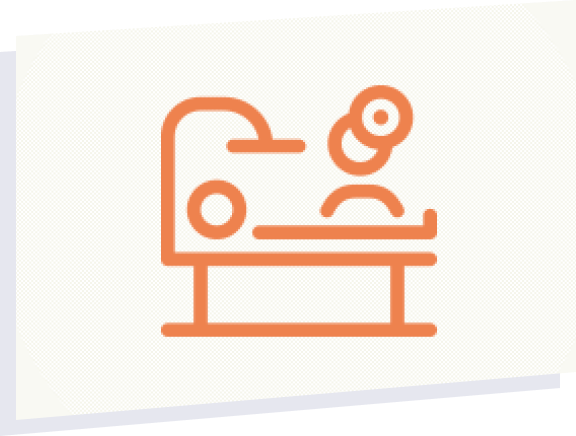
Leaves little to no scars
Since no incisions are made and only a small needle is inserted, there is almost no scarring.
-
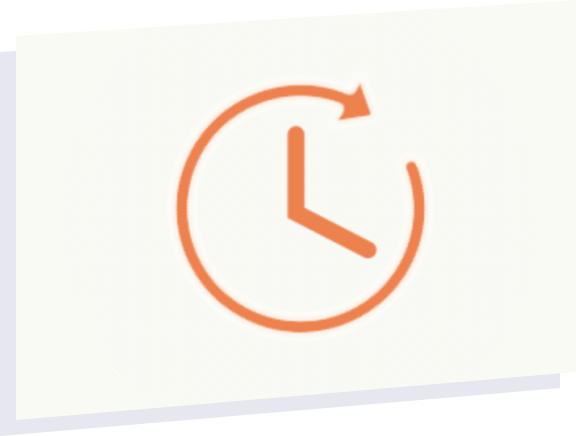
Lowered stress on the body Outpatient (day) treatment
Treatment time is about 15 minutes, and patients are required to rest for about 30 minutes after treatment. One can return home after about 60 minutes from the start of the treatment.
-
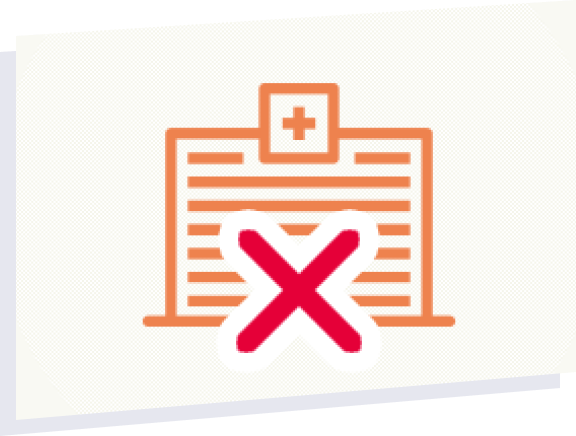
No need for post-treatment visits or rehabilitation
Even for those who live far away, there is no need for post-treatment hospital visits or rehabilitation, making it easier to return to work and daily routines.
How PLDD Works
The PLDD procedure is performed under local anesthesia. A needle is inserted through the back into the area of the affected herniated disc, and a laser fiber is passed through the path of the needle, and the laser cauterizes a portion of the nucleus pulposus in the disc, creating a cavity in the nucleus pulposus and causing the disc to shrink.
The resulting effects reduces pressure on the nerves to improve pain and numbness.

The PLDD method is effective for mild to moderate herniated discs, especially those that have high internal pressure and have not extruded from the ligament.
The Cellgel method is the more effective treatment for the extrusion and sequestrated types of herniation.

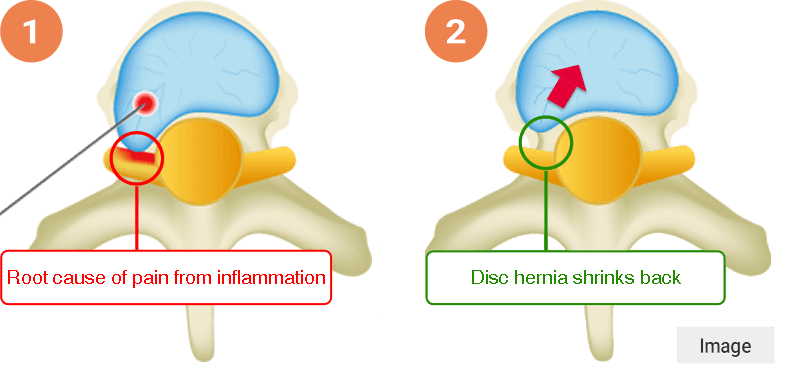
The nucleus pulposus in the intervertebral disc is cauterized with a laser to create a cavity.
This shrinks the protruding disc and reduces the pressure on the nerves.
Treatment time and side effects
- Treatment Time
- About 15 minutes
You will need to rest for about 30 minutes after treatment and you can go home after about 60 minutes. Light movement is possible from the next day onwards, but sports and strenuous activties must be put on hold for about a month.
-
Potential Drawbacks
A problem is that the recurrence rate is as high as that of conventional surgery. The reason for this is that PLDD does not improve disc damage in the same way the Cellgel method does.
-
Potential Side Effects
You may experience back pain, numbness, and muscle tension in your thighs that you have not had before after undergoing the PLDD treatment. It varies from person to person, but some may experience temporary symptoms for a week to a month after the surgery, depending on their symptoms and condition.
Although the risk is much lower than with surgical procedures, there is a risk of infection from the treated area and complications. In order to reduce these risks as much as possible, our doctors will explain the treatment in detail. Please consult with us if you have any questions or concerns prior to the treatment.
Flow The PLDD treatment process
-
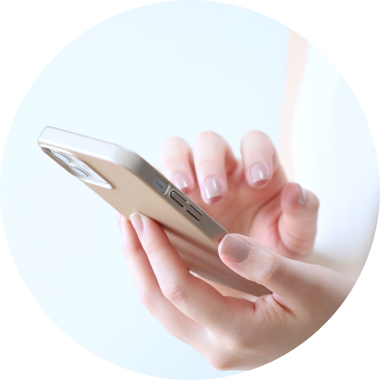
1. Inquiry
Our clinic is by appointment only, so be sure to make an appointment before visiting us.
Contact us on Whatsapp or by our contact form on this page.
-

2. Remote MRI Diagnosis
For Tokyo Clinic:
An MRI scan will be performed at a clinic affiliated with our clinic before your appointment at our clinic. Please send the MRI CD-ROM data to us via email prior to your visit. Also, if you have MRI images taken at another hospital, please let us know when you contact us.For Osaka Clinic:
The MRI scan will be performed at our clinic on the day of your appointment. -
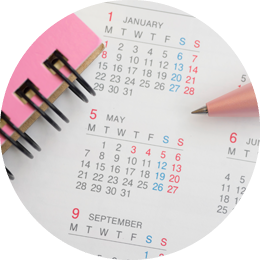
3. Choose Treatment Date
If the diagnosis confirms that you're a suitable candidate for our treatments, you may proceed to make an appointment with us. Kindly keep in mind the time it may take for you to secure a visa to enter Japan. A Japanese tourist visa is sufficient.
-

4. Travel Arrangements
As we are an outpatient facility, you will be discharged on the same day as your treatment. Patients are asked to take care of their own visas, travel and accommodation arrangements.
-
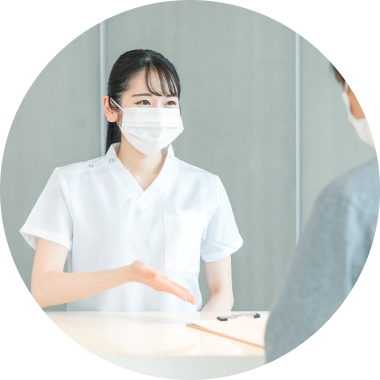
5. Pre-Treatment Examination
For Tokyo Clinic:
Please have your health insurance card, various medical certificates, image data, etc. ready when you come to the reception desk. After the check-in,, we will take X-ray images. After the X-ray, the doctor will spend approximately 30 minutes thoroughly examining the patient, and will consider and recommend the most suitable treatment plan for each patient.At the Osaka Clinic:
After the MRI/X-ray examination, the doctor will spend approximately 30 minutes thoroughly examining the patient, and will consider and propose the most appropriate treatment plan for each patient. -
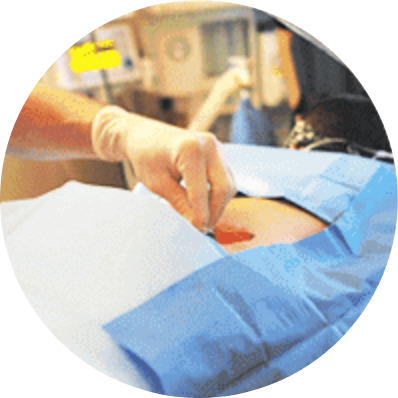
6. Treatment
Patients who wish to be treated on the same day can choose to be treated in the afternoon after the examination in the morning. Treatment time varies from 15 to 45 minutes (per site) after local anesthesia is administered.
-

7. Discharge
After the treatment, we provide a recovery room for you to rest for about an hour to 1.5 hours.
You are free to return home after the doctor examines you. -

8. Follow-up
We will contact you regularly for follow-ups after your treatment.
If you have any questions, please feel free to contact us.
Price PLDD Method Costs
| Number of Discs Treated |
1 disc | 2 discs | 3 discs | 4 discs | 5 discs |
|---|---|---|---|---|---|
| Treatment Cost | 308,000 JPY | 363,000 JPY | 418,000 JPY | 473,000 JPY | 528,000 JPY |
Swipe left/righ
* The cost of treatment is indicated including taxes.
*If treatment is performed at our clinic, all examination/diagnosis costs and test costs such as MRI are included in the above costs.
*This treatment method is not covered by Japanese health insurance, so you will have to pay for the entire treatment yourself.
*Payment by credit card (VISA, MasterCard, JCB, American Express, Diners, Discover) is also possible.
*If you would like rehabilitation (low back pain specialized rehabilitation), it is also possible to pay by bank transfer.
*If you live and work in Japan, you can receive a tax refund by filing your final medical expense return.
Other Treatment Methods
-
Cellgel Method
An advanced low back pain treatment method that started around 2010 and has been introduced in more than 54 countries around the world, mainly in Europe. This is a treatment method that treats a wide range of back pain diseases and symptoms.
-
Florence Method
A revolutionary new outpatient treatment for Spinal Stenosis! Used mainly in Europe and South America, it is now available at our clinic.
-
Hybrid Laser Method
This is a minimally invasive treatment for disc herniation that combines the benefits of both laser therapy (PLDD) and ozone therapy (PODD).
-
PODD Method(Percutaneous Ozone Disc Decompression)
Percutaneous Ozone Disc Decompression (PODD) has been performed mainly in Europe since the 1990s. It can be applied to facet joint disease, disc herniation, spinal canal stenosis, etc.
Our Treatment Methods versus Conventional Surgical Procedures
| Our clinic's treatments | Traditional Surgery | ||||||
|---|---|---|---|---|---|---|---|
| Cellgel | Hybrid Laser | PODD | PLDD | Florence |
Micro Endoscopic Discectomy (MED) |
Spinal Stabilization Vertebroplasty |
|
| Disc Restoration | ○ | × | × | × | × | × | × |
| Post-treatment Change in Disc Volume |
Same to increased | Slight to small decrease | Slight decrease | Small decrease | Same | Decreased or disappeared | Decreased or disappeared |
| Supressing of Inflammation |
○ | ○ | ○ | × | × | × | × |
| Duration of Treatment |
15–20 minutes | 20–25 minutes | 10–15 minutes | 10–15 minutes | 30 minutes | 40 minutes – 1 hour | 1–1.5 hours |
| Period of Hospitalization |
N/A (outpatient) |
N/A (outpatient) |
N/A (outpatient) |
N/A (outpatient) |
N/A (outpatient) |
About 1 week | About 1 month |
| Treatable Symptoms & Conditions |
Most lower back related conditions and symptoms | Disc herniation | Most lower back related conditions and symptoms | Disc herniation | Spinal canal stenosis, intervertebral disc hernia, facet joint disease, spondylolisthesis | Disc herniation, spinal tumor etc. | Spinal stenosis, spondylolisthesis, scoliosis, lumbar instability, intervertebral herniation, compression fracture |
Swipe left/righ
FAQ Questions About the PLDD method
-
QIs the treatment covered by the Japanese national health insurance?
-
ANo, it is not covered by the national insurance. If you have life insurance, you may be eligible. Please feel free to consult our staff regarding this matter.
-
QDoes the PLDD laser not burn discs?
-
AThe laser is applied to a defined area and does not burn through the intervertebral disc.
-
QCan the PLDD method be used in conjunction with other methods like Cellgel, etc.?
-
AThe PLDD method works by burning the disc to reduce its volume, causing the herniated area to retract into the disc.
The Cellgel method, on the other hand, has the function of repairing the intervertebral disc, so the purpose of treatment is different. The recommended treatment depends on the diagnosis of each patient.
-
QI've undergone surgery before - am I still eligible for PLDD?
-
ATreatment may be possible depending on the diagnosis. Please consult with us first.
-
QWill I need rehabilitation after treatment?
-
A
Walking and light stretching are recommended after treatment.
Even if the herniation can be reduced by the laser, muscle stiffness or muscle weakness may cause an inflammatory reaction and possibly recurrence. Please be sure to exercise moderately for prevention and recurrence.
We collaborate with rehabilitation facilities to provide specialized rehabilitation for back pain. Please see below for details.


